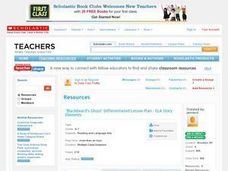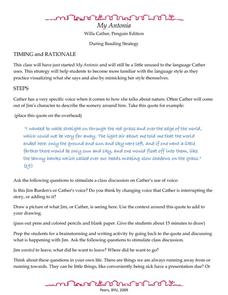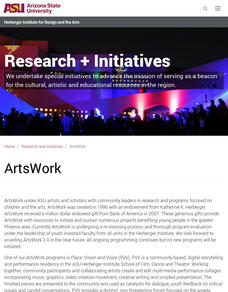Curated OER
Parts of a Story
Young scholars read a short fiction book and demostrate comprehension by identifying the main characters, setting, conflict, theme, and summarizing the main points. They organize the information in Inspiration and create a powerpoint to...
Curated OER
"Blackbeard's Ghost" Differentiated Lesson Plan
Develop a better understanding of "Blackbeard's Ghost" with this differentiated instructional activity. Working in groups on a creative project, middle schoolers can reinforce their reading comprehension and literary analysis skills. Use...
Curated OER
Native American Legends
Second graders will engage in an in-depth study of Michigan Native American culture comparing and contrasting the culture of today with that of the past. They will also read a variety of Native American literature focusing on the story...
Curated OER
My Antonia: During Reading Strategy
Home in on the quote on this page to explore setting, the author's and character's voices, and plot in Willa Cather's My Antonia. Pupils draw a picture of what is described in the quote, discuss the content, and make connections to their...
Curated OER
Narrative Writing-10 Strategies for Engaging the Reader
Fifth graders discuss what narrative writing represents. For this language arts lesson, 5th graders review the ten strategies for engaging reader. Students listen to and read good examples of each strategyand write engaging beginnings in...
Curated OER
Setting's Effect on a Character's Actions
Do the actions of a character in a story change based on the setting the writer provides? Learners explore the concept of character action in relation to story setting by investigating the setting and events in the story Science...
Curated OER
Analyzing Plot Conflict
Students explore the connection between analyzing a character and the character plot conflict. In this plot conflict lesson students role play two characters in the story, The Wizard of Oz by L. Frank Baum. Students also pretend to be a...
Curated OER
Lesson 2: Using Setting to Make Predictions about Characters
Fourth graders look at the importance of setting in a story. In this setting lesson, 4th graders see how the setting of a story affects the actions of the characters and how you can predict these actions based on the setting. They read...
Curated OER
Contrasting Cinderellas
Students compare and contrast the traditional Cinderella to the modern-day fairy tale, Cinder Edna. In this fairy tales lesson, students read both stories and construct a Venn diagram to compare the two fairy tales. Students identify how...
Curated OER
Robin Hood: England's Man of Mystery
Students study the tale of Robin Hood to further their knowledge of character traits, improve their vocabularies, and increase their knowledge of the Medieval Ages. In this Robin Hood lesson, students complete 14 lessons that help them...
Curated OER
As You Like It Couples Quiz: Fun Trivia Quiz
Are you studying As You Like It? If so, this online quiz might be useful for you! This quiz is made up of ten questions about the different relationships between the characters in William Shakespeare's play. Help your class get the...
Curated OER
Creating Scrolls Based on the Illustrated Tale of Genji
Now these are learning activities full of fun, art, and cultural exploration. Kids consider the art of storytelling through comic book images. They then look at the Tale of Genji as it was written in the 11th century. They discuss...
Curated OER
Big Pumpkin
Learners read a story and retell it through role playing. They will read Big Pumpkin, identify the main ideas and important characters, retell the story through dramatic play, and identify their favorite character.
Curated OER
Memoir
After reading and analyzing two narrative memoirs, middle schoolers engage in a variety of activities, including writing an essay, developing a story map, and creating character charts. They then compare and contrast story maps, and...
Curated OER
Where the Red Fern Grows Chapter 1 Worksheet
Break down Where the Red Fern Grows by Wilson Rawls into manageable chunks by focusing on plot points and literary elements in specific chapters. This resource is all about the first chapter, and asks pupils to use complete sentences to...
Curated OER
Rural Life During the Great Depression: A Year Down Yonder
“Anyone who thinks small towns are friendlier than big cities lives in a big city.” Mary Alice, the fifteen-year-old narrator of A Year Down Yonder, is forced to leave Chicago and spend a year with her Grandma Dowdel in a small rural...
Curated OER
Moby Dick Puppetry
Such an ambitious lesson! Third graders with special needs listen to an audio recording of the novel, Moby Dick. They stop often to discuss each of the main characters and analyze their actions in the story. They then make puppets of one...
Curated OER
Yellow Bird and Me
Upper elementary artists create works which demonstrate an understanding of the many elements of theater and the visual arts. This four-day plan combines many wonderful aspects of visual, musical, and theatrical arts into one very...
Curated OER
Oliver Twist Goes to Hollywood
How does Oliver Twist, the novel written by Charles Dickens, compare with its screenplay adaptation? Although the activity doesn't require learners to have read the novel, the similarities and differences of the highlighted passages...
Curated OER
Folktale Writing
Review literary analysis techniques with this reading lesson about folktale writing. Middle schoolers read different folktales from many authors, and write their own folktales to share with the class. They identify the plot, morals and...
Curated OER
Great Expectations: Group Writing
Examine the differences between totalitarianism and democracy in this writing lesson plan. Using the same format and theme from Great Expectations, young writers work in pairs to compose their own short stories. They follow guidelines...
K12 Reader
Storytelling and Folklore
Stories are passed down orally in many cultures. Learn about the ways that storytelling can shape a society with a reading passage about Native American folklore and myths. After they finish reading, kids complete five reading...
Annenberg Foundation
Gothic Undercurrents
Terror, mystery, excitement. American writers of the 19th century, including Nathaniel Hawthorne, Herman Melville, and Emily Dickinson, used these elements to create morally ambiguous tales that challenged the prevailing belief in...
Curated OER
Through the Eyes of the Big Bad Wolf
Imagine how the wolf would tell the tale of Little Red Riding Hood or The Three Little Pigs. Young writers re-imagine classic tales by adopting the point of view of another character in the story. After reading models like The True Story...

























